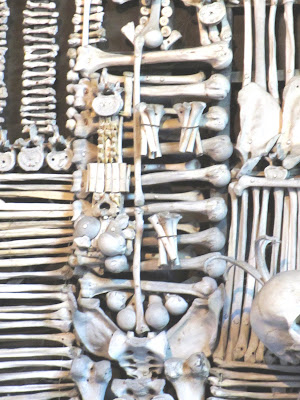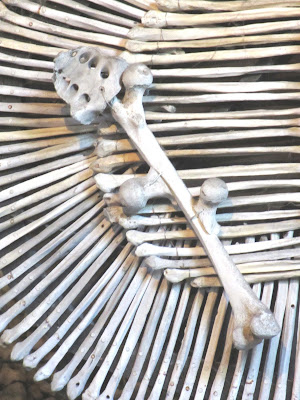In 1278, the
abbot of the Cistercian monastery in Sedlec, now in the Czech Republic, was
sent to the Holy Land by the King of Bohemia. He brought back a jar of “holy
soil” from Golgotha and sprinkled it over the abbey cemetery which caused the
cemetery to become a desired burial site for people living all over central
Europe. With the Black Death in the mid 1300s and the Hussite Wars in the early
1400s, thousands and thousands more people were buried there and the cemetery
had to be enlarged. Around 1400 a church was built in the cemetery with a
vaulted upper level and a lower chapel which was to be used as an ossuary for
the graves unearthed during construction of the church.
The white outer building in the picture below has stairs leading down into the ossuary chapel.
The cemetery outside the church.
An interesting grave marker in the cemetery.
In the picture below, the upper chapel is visible through a window with people behind it, and the lower bone chapel is visible below it, with stairs that are out of the picture leading down into it.
From 1703 to 1710 a new entrance was built to
support the front wall of the lower chapel and the upper chapel was rebuilt. In
1870, Frantisek Rint, a creative woodcarver, was employed by the Schwarzenberg
family, an aristocratic Bohemian and Franconian family, to put the bone heaps
into order. Using materials which we normally think of as gruesome, he created
some amazing works of art.
It is estimated that the ossuary contains the bones
of 40,000 to 70,000 bodies. Rint created four large heaps of bones, one in each
corner of the chapel.
He created a huge chandelier of bones which hangs from
the center of the nave,
(detail in the chandelier)
which contains at least one of each bone in the human
body. He made a Schwarzenberg coat of arms out of bones
(detail of the coat of arms)
and also left his
signature, made out of bone, on one of the walls.
Unfortunately, when we
visited, I didn’t even think to try and visit the upper church. Atop the church
spires, instead of the normal cross, there is a skull and cross bones.
The same
motif is found at various places on the outside wall of the cemetery
and
obviously inside the ossuary itself.
























I was not sure whether I should shiver or giggle here--maybe a bit of both.
ReplyDelete